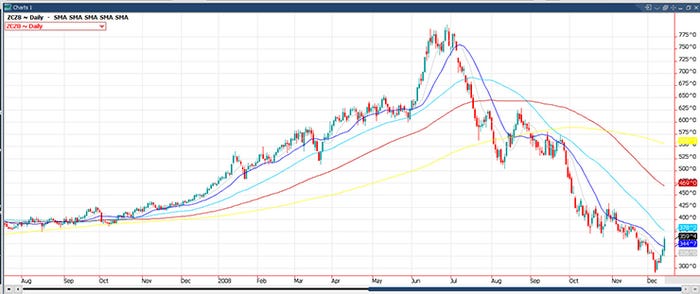
With planters in the south already rolling and the bulk of the Midwest likely to start within the next six weeks, most farmers are still not talking that much about planting. Given the incredible run our markets have seen over the last several weeks, the talk of the town has certainly been historically strong commodity prices.
Just 10 years ago we saw commodity prices go on a historic run as well. What can we learn from a year like 2012? Additionally, what can we learn from a year like 2008? Both years provide excellent learning opportunities.
Let’s actually start with lessons we can learn from 2012. In the Midwest, that crop went in the ground beautifully, partly due to how dry the spring was trending. The big problem with the dry spring is we never really got much moisture the rest of the summer either. Predictably the market rallied sharply, moving from $5.06 on June 15 to $7.95 on July 20 and eventually to a peak close of $8.38 on Aug. 21.
Corn prices in 2012

Lesson 1: Selling too much too fast
With such a sharp rally, producers understandably were making sales as we rallied. Given we were blessed with prices not seen before, some got over their skis a bit, selling too much corn. Some who sold grain in advance of harvest ended up not being able to fulfill contracts. For instance, some may have gotten 60% of their APH sold but only raised 40% of a crop.
The problem with this is many of those initial corn sales were at $5-$6. If their average sale price was at $6.50 and they sold for instance 20,000 too many bushels, IF those bushels were bought back at $8 to fulfill contracts, that’s a $30,000 hit.
That’s a mild example in comparison to some situations that unfolded in 2012.
So, lesson number one: Don’t get oversold on ’22 corn. We can hedge risk with floors or leveraged hedges, but don’t get overcommitted on physical bushels, especially with current drought conditions in the western Corn Belt and many meteorologists calling for a drier-than-normal summer.
Lesson 2: Markets can drop like a brick
There are also lessons to learn from 2008. In 2008 as the food-versus-fuel debate was full-steam ahead, commodity markets were in rally mode. It seemed bullish sentiment was as strong as many had ever seen. December corn closed over $7 from June 10 to July 10, which likely gave many a false sense that security prices wouldn’t drop anytime soon.
However, from the high of $7.88 on June 26 to July 23, we had dropped $1.98 all the way to $5.90. That drop was a small change though compared to what was yet to come. On Dec. 5 as December corn was about to expire, we closed at $2.93 ½. So Dec corn dropped from the high to the low by a few pennies less than $5 per bushel
Corn prices in 2008

Lesson number two? Don’t assume these markets can’t drop like a brick. We’ve seen it happen before and given the craziness in our world today, it would be unwise to assume any sort of market action is a possibility.
If we look at these two extreme examples of the last time we saw record corn prices, we can learn from our mistakes. First, let’s be flexible in our marketing plans. I strongly recommend respecting the potential explosiveness of this market when executing your marketing plan. Getting overcommitted on physical bushels could be devastating for a producer if they can’t raise the crop they’re planning on.
With that being said, many may want to sit and wait on the market to rally ‘closer to the highs’. The problem with that line of thought is there are no guarantees in this market. The explosiveness we talked about can work both ways. In the event our world situation improves, South America’s safrinha crop is a big one, and the U.S. plants big corn acreage, we could be looking at significantly lower prices by this fall.
If we do nothing with these elevated prices, it could be our biggest mistake. However, if what we do isn’t flexible in nature, it could also cause us major problems.
My challenge for producers is to spend plenty of time thinking through the best way to lock in a worst-case scenario while leaving room for some serious upside this marketing year. Consider all the risk management tools at our disposal.
I wish you much success for this 2022 growing season that lies ahead!
Feel free to reach out to me or anyone on the AgMarket team. We’d love to hear from you.
Reach Matt Bennett at 815-665-0462 or [email protected].
The risk of loss in trading futures and/or options is substantial and each investor and/or trader must consider whether this is a suitable investment. AgMarket.Net is the Farm Division of John Stewart and Associates (JSA) based out of St Joe, MO and all futures and options trades are cleared through ADMIS in Chicago IL. This material has been prepared by an agent of JSA or a third party and is, or is in the nature of, a solicitation. By accepting this communication, you agree that you are an experienced user of the futures markets, capable of making independent trading decisions, and agree that you are not, and will not, rely solely on this communication in making trading decisions. Past performance, whether actual or indicated by simulated historical tests of strategies, is not indicative of future results. Trading information and advice is based on information taken from 3rd party sources that are believed to be reliable. We do not guarantee that such information is accurate or complete and it should not be relied upon as such. Trading advice reflects our good faith judgment at a specific time and is subject to change without notice. There is no guarantee that the advice we give will result in profitable trades. The services provided by JSA may not be available in all jurisdictions. It is possible that the country in which you are a resident prohibits us from opening and maintaining an account for you.
The opinions of the author are not necessarily those of Farm Futures or Farm Progress.
About the Author(s)
You May Also Like






